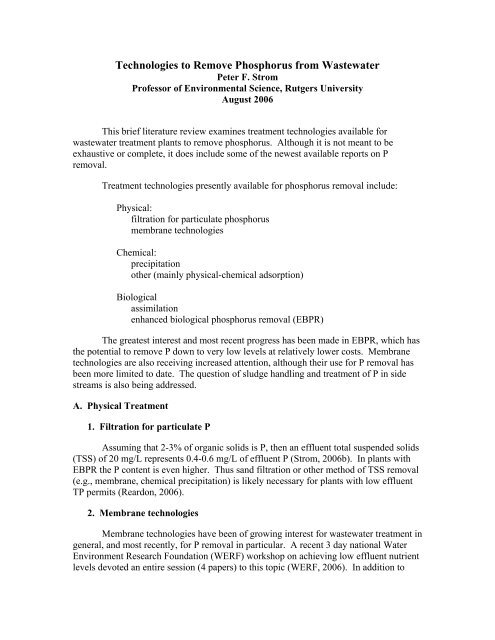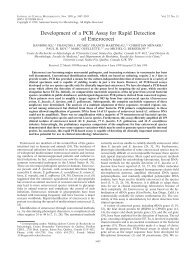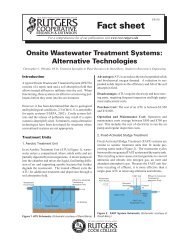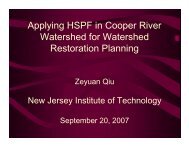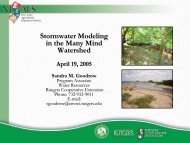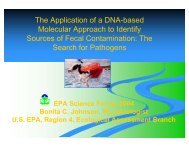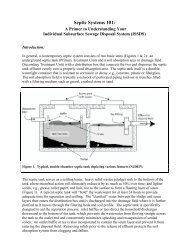Technologies to Remove Phosphorus from Wastewater
Technologies to Remove Phosphorus from Wastewater
Technologies to Remove Phosphorus from Wastewater
Create successful ePaper yourself
Turn your PDF publications into a flip-book with our unique Google optimized e-Paper software.
Converting a non-P removing activated sludge <strong>to</strong> EBPR by acclimatization <strong>to</strong>alternating anaerobic and aerobic conditions takes 40-100 days, but many EBPR systemsexperience start-up failure or breakdown (Dabert et al., 2005). Bioaugmentation(inoculating with previously adapted microorganisms) was found <strong>to</strong> speed up the processfor a labora<strong>to</strong>ry SBR by about 15 days compared <strong>to</strong> a non-augmented control.Optimization of dissolved oxygen, sludge age, and nitrate-N concentration forefficient phosphorus removal were tested at an A2O wastewater treatment plant in Guilin,China, (Li et al., 2005). Results showed that DO must be controlled in the anaerobicphase, nitrate-nitrogen concentration must be decreased in the anaerobic section, and asludge age of 8-10 days was preferable <strong>to</strong> 15 days.Kuba et al. (1997) examined the role of denitrifying phosphorus removingbacteria (DPB) in wastewater treatment plants using batch tests with activated sludge<strong>from</strong> two plants in the Netherlands. DPBs appeared <strong>to</strong> be of little importance in oneplant, but contributed substantially <strong>to</strong> P removal in the other.D. Sludges and Side StreamsThere is some concern about the effects of solids management processes andreturn side streams on the ability <strong>to</strong> remove P <strong>to</strong> low levels. Processes that destroyorganic material (such as digestion) have the potential <strong>to</strong> release the particulate organic-Ppresent as soluble organic or inorganic P. In particular, anaerobic conditions are likely <strong>to</strong>release soluble P <strong>from</strong> EBPR sludges and iron precipitates (ferrous phosphate is muchmore soluble than ferric phosphate). Any released P may then be returned <strong>to</strong> the mainwastewater treatment process in high concentrations through recycle side streams, thusrequiring removal a second time. Non-continuous processes may also lead <strong>to</strong> variableloadings <strong>from</strong> side streams. A number of these issues were discussed by Narayanan(2006).In some cases, these problems, particularly with anaerobic digestion, have notbeen as severe as originally anticipated, or could be controlled (deBarbadillo, 2006).This appears in part <strong>to</strong> be related <strong>to</strong> the formation of the mineral struvite, MgNH 4 PO 4 .Struvite has long been known for its potential <strong>to</strong> cause clogging in anaerobic digesters(Vaccari et al., 2006), where ammonium and phosphate are released as the organic matteris degraded. However, it appears that formation of this mineral in digesters at EBPRplants may lead <strong>to</strong> its precipitation as small granules that remain with the sludge, ratherthan the release of soluble P <strong>to</strong> the supernatant where it would be recycled. This isapparently enhanced by the liberation of Mg 2+ by PAOs as a major associated cationduring phosphate release (Liao et al., 2003).Another approach is <strong>to</strong> remove the P <strong>from</strong> the recycle stream. Brit<strong>to</strong>n et al.(2005) demonstrated treatment of anaerobic digester supernatant in pilot scale using afluidized bed reac<strong>to</strong>r. Phosphate was recovered in the form of struvite through theaddition of magnesium chloride and pH adjustment. Liao et al. (2003) looked at releaseof P directly <strong>from</strong> EBPR sludge by several methods for possible P recovery. Takiguchi et5
al. (2004) tested thermal (70 ◦ C) treatment followed by precipitation with Ca in a labscale.AcknowledgmentsI would like <strong>to</strong> thank Erin Murphy and Amy Boyajian for their contributions <strong>to</strong>this review.Literature CitedAkin, B.S. and A. Ugurlu. 2003. Biological removal of carbon, nitrogen and phosphorusin a sequencing batch reac<strong>to</strong>r. Journal of Environmental Science and Health, 38, 1479-1489.Awuah, E., M. Oppong-Peprah, H.J. Lubberding, and H.J. Gijzen. 2004. Comparativeperformance studies of water lettuce, duckweed, and algal-based stabilization pondsusing low-strength sewage. Journal of Toxicology & Environmental Health, 67, 1727-1739.Barnard, J. 2006. Requirements for achieving effluent phosphorus of less than 0.1 mg/L.Session P1 in WERF, 2006.Brit<strong>to</strong>n, A., F.A. Koch, D.S. Mavinic, A. Adnan, W.K. Oldham, and B. Udala. 2005.Pilot-scale struvite recovery <strong>from</strong> anaerobic digester supernatant at an enhancedbiological phosphorus removal wastewater treatment plant. Journal of EnvironmentalEngineering & Science, 4, 265-277.Dabert, P., J.P. Delgenes, and J.J Godon. 2005. Moni<strong>to</strong>ring the impact ofbioaugmentation on the start up of biological phosphorus removal in a labora<strong>to</strong>ry scaleactivated sludge ecosystem. Applied Microbiology & Biotechnology, 66, 575-588.deBarbadillo, C. 2006. Biological phosphorus removal at the McDowell Creek WWTP.Session P1 in WERF, 2006.Emrick, J. 2006. Cold weather BNR limits. Session P1 in WERF, 2006.Hermanowicz, S. 2006. Chemical fundamentals of phosphorus precipitation. Session P2in WERF, 2006.Kuba, T., M.C.M. van Loosdrecht, F.A. Brandse, and J.J. Heijnen. 1997. Occurrence ofdenitrifying phosphorus removing bacteria in modified UCT-type wastewater treatmentplants. Water Research, 31, 777-786.Li, J., H. Ren, X. Wang, Q. Liu, and Q. Xie. 2005. Technique for biological phosphorusremoval. Pollution Engineering, 37, 14-17.Liao, P.H., D. Mavinic, and F.A. Koch. 2003. Release of phosphorus <strong>from</strong> biologicalnutrient removal sludges: A study of sludge pretreatment methods <strong>to</strong> optimizephosphorus release for subsequent recovery purposes. Journal of EnvironmentalEngineering & Science, 2, 369-381.Little<strong>to</strong>n, H.X., G.T. Daigger, P.F. Strom, & R.M. Cowan. 2000. Evaluation ofau<strong>to</strong>trophic denitrification and heterotrophic nitrification in simultaneous biological6


